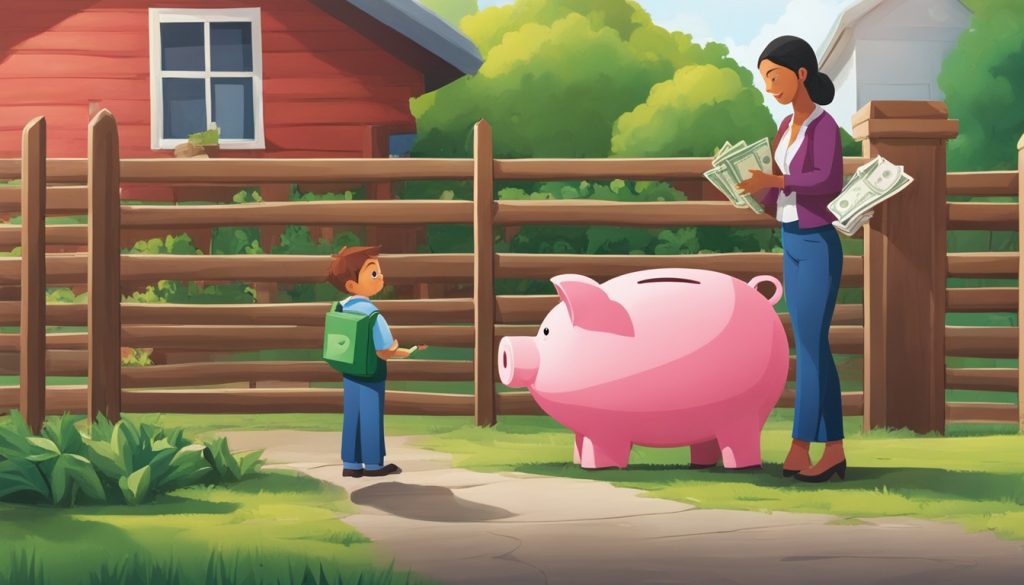Remember your first time earning money? It might have been from an allowance, doing chores, or running a lemonade stand. The feeling of having money was exciting and a bit scary. If someone had taught you about budgeting, saving, and investing back then, your financial life might be different now.
Many of us didn’t learn about money when we were young. This lack of knowledge can make managing money hard later on. Experts like Carrie Schwab-Pomerantz and Chris Kawashima say that financial literacy for kids is key. It helps ensure they’ll be financially secure in the future.
Talking about money with your kids might seem hard, but it’s important. Regular chats can make money less mysterious. Jen Hemphill, a financial expert, suggests having a family money talk once a month. This helps teach them good financial behaviors from a young age.
Key Takeaways
- Teaching kids about money early helps secure their financial future.
- Talking about money often makes it easier for kids to understand.
- Between ages 6 and 12, kids develop their financial habits.
- Early financial education makes saving and budgeting easier.
- Parents play a big role in teaching kids about money management.
Why Financial Literacy is Crucial for Kids
Financial literacy is more than just handling money. It’s about setting a strong base for the future. Teaching kids early helps them make smart money choices. This way, they avoid mistakes in saving and spending.
By learning about money early, kids can be more careful with their cash. This leads them to a stable financial future.
Understanding Money Management Early On
Teaching kids about money means teaching them to save, budget, understand taxes, and invest. Learning these early helps them avoid common money mistakes. For example, many kids don’t know about saving for retirement or where their money goes when they buy things.
Starting with these basics makes kids better at saving and spending wisely. These skills are key for financial health.
Knowing about money is crucial for success in life and business. It helps them make better choices about their money. They’ll be ready for big financial steps like investing, getting insurance, and saving for the future.

Building Confidence and Responsibility
Learning about money also helps kids feel confident and proud of themselves. When they know how to manage their money, they feel good about it. This confidence helps them in all areas of life, making them better at making decisions and taking responsibility.
Tools like apps, books, and games make learning about money fun. Kids can use digital media and social media to learn too. These tools prepare them well for handling money in the future.
Grandparents also play a big role in supporting their grandkids’ education. They offer emotional support and make learning fun at home. This helps kids do better in school and builds strong family bonds. It shows how important it is to teach kids about money.
A big 86 percent of Americans think financial education should be a must in schools from K-12. But, many states don’t offer it. This means parents and caregivers need to step up and teach their kids about money.
| Skills | Importance | Methods |
|---|---|---|
| Saving | Secures future finances | Financial games, apps |
| Budgeting | Prevents overspending | Books, digital media |
| Investing | Builds wealth | Starting a microbusiness |
| Taxes | Understood financial obligations | Direct instruction, allowances |
Starting Conversations About Money
Talking about money with your kids can be easy and part of daily life. Start these talks early, like in the second or third grade, when they can understand basic math. This sets the stage for a lifetime of learning about money.
Using Everyday Experiences
Learning about money can come from everyday activities. For example, let your kids help with the grocery budget. Give them a set amount to spend while shopping. This teaches them how to manage money well.
Talking about real expenses, like a cell phone bill or a family trip, helps kids see the big picture. It teaches them about financial responsibility and emotional intelligence.

Talking with your kids about financial goals and good money habits is key. Use credit card statements or bills to show the difference between wants and needs. This helps them see how their choices affect the family.
Explaining Wants vs. Needs
Teaching kids to tell needs from wants is vital for managing money. Use their everyday life to explain this. For example, choosing between a toy or saving for something they want.
Encourage them to put their allowance into spending, saving, and giving. This teaches them to budget and think about their choices. It also boosts their emotional smarts.
Learning about money early gives kids the skills to make smart financial choices later. Regular, meaningful talks about money prepare them for their financial future. This helps them become financially savvy.
Introducing Allowances and Chores
Starting with allowances and chores is a key step in teaching kids about money. It’s important to set clear rules for earning and handling money. This helps kids learn about responsibility, hard work, and the value of money.
Setting Boundaries with Allowances
It’s crucial to set clear rules for allowances to teach kids about money management early. Experts suggest starting allowances at 4 or 5 years old. The $1 per year rule is a good start, giving a child one dollar per week for each year of age.
When deciding on an allowance, think about what it should cover. Consider savings, giving to charity, personal activities, and lunch money. For teens, a lump sum for specific needs like clothes teaches them to budget.
Parents should give an allowance that makes kids think twice. This teaches them to save and make smart spending choices. Most U.S. parents give their kids an allowance, with the average being $19.39 a week. Many parents give between $11 to $20 weekly.

Teaching Work Ethic Through Chores
Combining allowances with chores is a great way to teach kids about hard work. Most parents make kids work for their allowance, with common tasks like mowing the lawn or washing dishes. This helps kids feel they’re part of the household team.
Doing chores shows kids that money comes from effort. Encouraging them to save for something teaches patience and discipline. Most kids value talking about money with parents, and teens see financial knowledge as key.
A good allowance plan separates it from chores to keep kids motivated. Experts say paying for chores might make them seem less appealing. Calling them “family contributions” helps kids feel they belong and are part of the team. Teaching kids about money early helps them manage it better later on. With the right approach, kids learn to value their money and develop good financial habits.
| Age | Allowance Range (Per Week) | Responsibilities Covered |
|---|---|---|
| 5-7 years | $5 – $7 | Personal activities, small savings |
| 8-10 years | $8 – $10 | Toys, games, small savings goals |
| 11-13 years | $11 – $13 | School supplies, extracurricular activities |
| 14-16 years | $14 – $16 | Personal activities, larger savings items |
| 17+ years | $17 – $20 | Clothing, social outings, savings for future |
The Power of Saving: Piggy Banks to Bank Accounts
Teaching your kids about saving is a great way to boost their financial knowledge and independence. Starting with piggy banks makes saving seem real and close. Then, moving to bank accounts deepens their financial understanding and security.

Making Saving Tangible
Using a piggy bank helps kids see the value of saving in a simple way. You can make it more exciting by linking it to their hobbies. For example, saving for a toy or book they want. This makes saving fun and connects it to things they like.
As the piggy bank gets full, they’ll see their hard work pay off. This encourages them to keep saving.
Long-Term Saving Goals
Switching to bank accounts is a big step in teaching kids to be independent. Bank accounts are safe for their money, protecting it from harm. They also let kids earn interest, showing how money can grow over time.
Checking accounts let kids use debit cards for everyday spending, like buying lunch or going to the movies. Savings accounts earn interest and help kids save for big goals. Saving for something big, like a bike or a game console, teaches them to stick to their goals.
Teaching kids to save a part of their allowance or gifts helps them develop good financial habits. As technology grows, apps like Venmo or Cash App can introduce them to digital money. But, traditional bank accounts are still key for handling big money like paychecks or bills. This mix of piggy banks, digital tools, and bank accounts prepares kids for managing money in the future.
Encouraging Part-Time Work and Entrepreneurial Ventures
Starting with a lemonade stand or selling Star Wars cards, kids learn valuable lessons. These early jobs help them understand the value of hard work and money management. Parents who are entrepreneurs play a big role in shaping their kids’ entrepreneurial spirit.
Benefits of Early Jobs
Early jobs teach kids about responsibility and important life skills. By working part-time, they learn the value of hard work and how to manage money. This is a great way to Build Resilience in Kids as they deal with the ups and downs of earning and saving.
- Instills sense of responsibility
- Develops budgeting skills
- Encourages hard work
Starting a Microbusiness
Encouraging kids to start a small business boosts their creativity and entrepreneurial spirit. For example, selling cards door-to-door or running an online store teaches them about customer service and managing supplies. This not only boosts Encouraging Child Creativity but also prepares them for future careers.
- Identify a niche market
- Develop a business plan
- Launch and market the business
Even if these early businesses don’t succeed, kids learn a lot. They get better at solving problems and thinking creatively. Introducing entrepreneurial activities early can shape their future careers and build resilience. Supporting these small businesses helps raise a generation of innovative and resilient people.
Understanding Budgeting and Spending
Learning how to budget and spend money is key for kids to grow financially smart. By making and sticking to a budget, they learn about money limits and what they really need. This is vital for their money management later on.
Teaching kids about budgeting is a big part of Teaching Kids Responsibility. It helps them manage their money well.
Creating and Sticking to a Budget
First, guide kids in making their own budget. They should list their income, like allowance or part-time jobs, and sort expenses into needs and wants. A budget planner can be super useful here.
It’s key to show them the need to spend less than they make. For example, the 70/20/10 budget rule (70% for bills, 20% for savings, and 10% for debt) teaches a good way to handle money. This helps kids see the importance of saving and planning.
Learning About Trade-Offs
Budgeting means making choices, and kids should learn to think carefully about their spending. For example, they might have to decide between saving for a Disney trip or eating out more often. A Disney trip for a family of four can cost about $3,793 for three days.
By managing screen time well, kids can also learn to prioritize. Talk about the trade-offs between spending on games or shows versus saving for big goals. This helps them see the real cost of their choices and improves their decision-making.
Budgeting is more than just cutting costs; it’s a way to secure financial future and independence. By getting kids involved, parents teach them valuable financial skills. Open talks and ongoing learning are key to making these lessons stick.
Teaching Kids About Credit and Debt
Teaching your kids about credit and debt is key for good money management. It’s important to start early to help them make smart money choices later. Understanding credit and debt helps them become financially smart. Start by letting them enjoy hobbies that teach real-life money skills, like budgeting and saving for big buys.
Start by explaining the basics of credit and debt. Use examples they can relate to, like borrowing a game from a friend and returning it in good shape. Explain how credit cards work and the dangers of high-interest debt. Talk about how they’ll get credit card offers at 18, especially if they’re in college. Use this chance to stress the importance of waiting a day before buying something over $15, teaching them discipline.
“Money habits in children are mostly formed between the ages of 6 and 12. Understanding credit and debt at this stage sets a solid foundation for future financial health.”
— Financial Experts
Make these lessons real by using simple tables or lists. These can compare different financial tools and their effects.
| Credit Type | Description | Implication |
|---|---|---|
| Credit Cards | Short-term borrowing with a credit limit. | High-interest debt if not paid on time. |
| Student Loans | Borrowed money to finance education. | Long-term debt that accrues interest over time. |
| Mortgages | Loans for purchasing property. | Secured debt that requires monthly payments for years. |
Encourage kids to track their spending and understand debt’s effects. Create a mock credit game where they “borrow” points and see the impact of late payments. This makes the idea clear and teaches them to handle credit well.
Talk about real-world examples from companies like Eastspring Investments. They show how credit systems work in different places, like Singapore or the U.S. This can be a deeper lesson once they understand the basics.
Teaching these values early helps kids manage their money well and avoid debt. The aim is to build habits that last a lifetime.
Introducing Investing to Children
Teaching kids about investments early can boost their financial smarts. Making it fun and easy to understand helps them see mistakes as chances to learn. This prepares them for smart risks later on.
Opening Custodial Accounts
Starting custodial accounts is a great way to get kids into investing. These accounts let kids own and invest in things like stocks and bonds. Companies like Nike, Apple, or Boeing can make learning about the stock market fun and real.
This hands-on approach helps kids learn about money early on. It sets them up for success later in life.
Basics of Stocks and Bonds
Learning about stocks and bonds is key to understanding money. Stocks let you own part of a company and could bring in big gains over time. The stock market has grown a lot over the years, showing it can be a good long-term choice.
Bonds are safer but don’t make as much money. They’re backed by things like banks or governments. They pay a bit more than the basic interest rate, making them a good start for beginners.
Certain exercises, such as the Doubling Penny Exercise, can show kids the power of saving and investing.
Here’s a simple guide to help kids see the difference between stocks and bonds:
| Investment Type | Risk Level | Potential Return | Typical Backers |
|---|---|---|---|
| Stocks | High | High | Private Companies |
| Bonds | Low | Low | Banks, Governments |
By using custodial accounts and exercises like these, parents can help kids grow into smart, confident investors.
Parenting and Raising Kids Through Financial Challenges
Many families face financial challenges. About 60% of parents in the U.S. say preschool and daycare costs are a big financial burden. It’s key to talk openly with your kids and support them during tough times.
When talking to your kids about money issues, explain things they can understand. Being honest about money problems helps you handle tantrums better. It’s important to make them feel loved and secure, even when money is tight.
“In a 2018 survey of 1,000 parents in the United States, conducted by Credit Karma, 67% of respondents went into debt to purchase necessary items for their children like food, clothes, and shoes.”
It’s important to know how money stress affects kids’ mental health. 40% of U.S. parents worry their kids might get anxious or depressed. This shows why supporting kids’ mental health is key during hard times.
Changing your financial plans can help your family and kids during tough times. Setting clear goals for spending and saving makes kids feel involved in solving problems. This approach teaches them about money and helps them be more resilient.
Dealing with tantrums when money is tight requires patience and consistency. Over 69% of parents hide their debt from others. Talking openly about money issues can make your family stronger.
In conclusion, supporting your child’s mental health means creating a supportive environment. Teaching them to be flexible with money prepares them for the future. This approach helps them grow into successful adults.
Using Games and Apps to Teach Financial Skills
Games and apps make learning about money fun for kids. They help manage screen time and boost creativity. Kids learn financial skills through play, making it interactive and enjoyable.
Educational Board Games
Board games are great for teaching kids about money. Monopoly and Payday let kids practice real-life financial situations in a fun way. These games help kids think strategically and learn about money management.
For younger kids, games like Learning Coins and Money Bingo are perfect. They make learning about money fun and easy. These games help kids understand complex financial ideas in a simple way.
- Monopoly: Teaches property investment, rent management, and basic economics.
- Payday: Focuses on monthly budgeting, spending, and saving.
- Learning Coins: Introduces young kids to the value and identification of different coins.
- Dollar Dive: Engages kids in understanding monetary value through underwater adventures.
Financial Literacy Apps
Apps are becoming popular for teaching kids about money. They make learning fun and help manage screen time. Zogo is a great app with over 400 modules on different financial topics.
Apps like Financial Football and Hot Shot Business make learning about money exciting for middle school students. High schoolers can use apps like The Stock Market Game and Misadventures in Money Management. These apps simulate real financial situations and teach decision-making.
- Zogo: Provides extensive modules on diverse financial subjects.
- Financial Football: Combines sports and financial decisions to teach budgeting and saving.
- The Stock Market Game: Helps students understand investments and stock market dynamics.
- Misadventures in Money Management: Guides students through financial choices in a story-based format.
These tools help schools and families teach kids about money in a balanced way. They mix screen time with creativity to create a strong financial education.
Instilling the Value of Philanthropy
Teaching kids about philanthropy is key to financial literacy. It’s not just about handling money. It’s about teaching them to be generous, empathetic, and socially responsible. By doing this, you help raise kind kids who respect family and understand others.
Adding philanthropy to your child’s life shows them the value of giving back. This can shape their future in a big way.
Encouraging Donations
Starting with small donations is a good way to teach kids about giving. Use the 3-part allowance system to teach them to save, spend, and give. Encourage them to put a little money in a “Share” jar for charity each month.
This teaches them about money and social responsibility. Research shows that kids whose parents give are more likely to give too. This creates a cycle of kindness.
Talking about giving and doing community service helps too. Events like Martin Luther King Jr. Day of Service or Random Acts of Kindness Day are great for this. They show kids the value of helping others and can make them feel good about making a difference.
Teaching Social Entrepreneurship
Teaching kids about social entrepreneurship is another great way to teach them about giving. Social entrepreneurship is about making money to solve social problems. It’s a mix of business and helping others.
Encourage kids to think of ways their hobbies can help others. For example, a baking hobby could help raise money for a local shelter. This teaches them how their passions can make a difference.
How kids learn from us is important. Wealth counselors suggest talking about money to share your values. By doing this, you help your kids grow into caring, aware adults who help their communities.
FAQ
When should I start teaching my kids about financial literacy?
How can I explain the difference between wants and needs to my children?
What are some practical ways to help my children understand saving?
How can allowances and chores help in developing financial literacy in children?
What are the benefits of introducing part-time work to my children?
How can I teach my kids about budgeting and spending?
When should I start discussing credit and debt with my kids?
How can I introduce investing to my children?
What should I do if my family is facing financial challenges?
Are there any educational games or apps that can help teach financial skills?
How can I instill the value of philanthropy in my children?
This post contains affiliate links. If you click on a link and make a purchase, I may earn a small commission — at no extra cost to you. Thank you for supporting this blog and helping me keep the patterns free! Read the full Affiliate Disclosure & Transparency.
